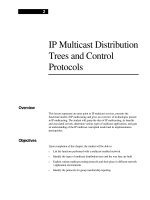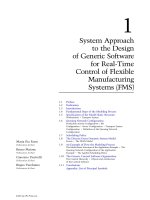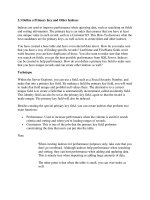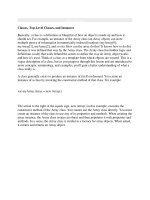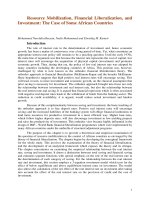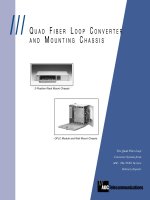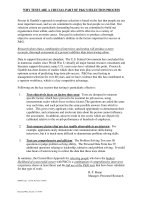Tài liệu Alcohol-use disorders: diagnosis, assessment and management of harmful drinking and alcohol dependence docx
Bạn đang xem bản rút gọn của tài liệu. Xem và tải ngay bản đầy đủ của tài liệu tại đây (211.38 KB, 51 trang )
Alcohol-use disorders:
diagnosis, assessment and
management of harmful
drinking and alcohol
dependence
Issued: February 2011
NICE clinical guideline 115
guidance.nice.org.uk/cg115
NICE has accredited the process used by the Centre for Clinical Practice at NICE to produce
guidelines. Accreditation is valid for 5 years from September 2009 and applies to guidelines produced
since April 2007 using the processes described in NICE's 'The guidelines manual' (2007, updated
2009). More information on accreditation can be viewed at www.nice.org.uk/accreditation
© NICE 2011
Contents
Introduction 4
Person-centred care 7
Key priorities for implementation 8
1 Guidance 12
1.1 Principles of care 12
1.2 Identification and assessment 14
1.3 Interventions for alcohol misuse 18
2 Notes on the scope of the guidance 35
3 Implementation 36
4 Research recommendations 37
4.1 Is contingency management effective in reducing alcohol consumption in people who misuse
alcohol compared with standard care? 37
4.2 What methods are most effective for assessing and diagnosing the presence and severity of
alcohol misuse in children and young people? 38
4.3 Is acupuncture effective in reducing alcohol consumption compared with standard care? 39
4.4 For which service users who are moderately and severely dependent on alcohol is an assertive
community treatment model a clinically and cost-effective intervention compared with standard care? 39
4.5 For people with moderate and severe alcohol dependence who have significant comorbid
problems, is an intensive residential rehabilitation programme clinically and cost effective when
compared with intensive community-based care? 40
4.6 For people with alcohol dependence, which medication is most likely to improve adherence and
thereby promote abstinence and prevent relapse? 41
5 Other versions of this guideline 43
5.1 Full guideline 43
5.2 Information for the public 43
6 Related NICE guidance 44
7 Updating the guideline 45
Appendix A: The Guideline Development Group and National Collaborating Centre 46
Alcohol-use disorders: diagnosis, assessment and management of
harmful drinking and alcohol dependence
NICE clinical
guideline 115
© NICE 2011. All rights reserved. Last modified February 2011 Page 2 of 51
Guideline Development Group 46
Appendix B: The Guideline Review Panel 49
About this guideline 50
Alcohol-use disorders: diagnosis, assessment and management of
harmful drinking and alcohol dependence
NICE clinical
guideline 115
© NICE 2011. All rights reserved. Last modified February 2011 Page 3 of 51
Introduction
This guideline makes recommendations on the diagnosis, assessment and management of
harmful drinking and alcohol dependence in adults and in young people aged 10–17 years.
This is one of three pieces of NICE guidance addressing alcohol-related problems and should be
read in conjunction with:
Alcohol-use disorders: preventing the development of hazardous and harmful drinking. NICE
public health guidance 24 (2010). Public health guidance on the price, advertising and
availability of alcohol, how best to detect alcohol misuse in and outside primary care, and
brief interventions to manage it in these settings.
Alcohol-use disorders: diagnosis and clinical management of alcohol-related physical
complications. NICE clinical guideline 100 (2010). A clinical guideline covering acute
unplanned alcohol withdrawal including delirium tremens, alcohol-related liver damage,
alcohol-related pancreatitis and management of Wernicke's encephalopathy.
Harmful drinking is defined as a pattern of alcohol consumption causing health problems directly
related to alcohol. This could include psychological problems such as depression, alcohol-related
accidents or physical illness such as acute pancreatitis. In the longer term, harmful drinkers may
go on to develop high blood pressure, cirrhosis, heart disease and some types of cancer, such
as mouth, liver, bowel or breast cancer.
Alcohol dependence is characterised by craving, tolerance, a preoccupation with alcohol and
continued drinking in spite of harmful consequences (for example, liver disease or depression
caused by drinking). Alcohol dependence is also associated with increased criminal activity and
domestic violence, and an increased rate of significant mental and physical disorders. Although
alcohol dependence is defined in ICD-10 and DSM-IV in categorical terms for diagnostic and
statistical purposes as being either present or absent, in reality dependence exists on a
continuum of severity. However, it is helpful from a clinical perspective to subdivide dependence
into categories of mild, moderate and severe. People with mild dependence (those scoring 15 or
less on the Severity of Alcohol Dependence Questionnaire; SADQ) usually do not need assisted
alcohol withdrawal. People with moderate dependence (with a SADQ score of between 15 and
30) usually need assisted alcohol withdrawal, which can typically be managed in a community
setting unless there are other risks. People who are severely alcohol dependent (with a SADQ
score of more than 30) will need assisted alcohol withdrawal, typically in an inpatient or
Alcohol-use disorders: diagnosis, assessment and management of
harmful drinking and alcohol dependence
NICE clinical
guideline 115
© NICE 2011. All rights reserved. Last modified February 2011 Page 4 of 51
residential setting. In this guideline these definitions of severity are used to guide selection of
appropriate interventions.
For convenience this guideline refers to harmful drinking and alcohol dependence as 'alcohol
misuse'. When recommendations apply to both people who are dependent on alcohol and
harmful drinkers, the terms 'person who misuses alcohol' or 'service user' are used unless the
recommendation is specifically referring to either people who are dependent on alcohol or who
are harmful drinkers.
Alcohol dependence affects 4% of people aged between 16 and 65 in England (6% of men and
2% of women), and over 24% of the English population (33% of men and 16% of women)
consume alcohol in a way that is potentially or actually harmful to their health or well-being.
Alcohol misuse is also an increasing problem in children and young people, with over 24,000
treated in the NHS for alcohol-related problems in 2008 and 2009.
Comorbid mental health disorders commonly include depression, anxiety disorders and drug
misuse, some of which may remit with abstinence from alcohol but others may persist and need
specific treatment. Physical comorbidities are common, including gastrointestinal disorders (in
particular liver disease) and neurological and cardiovascular disease. In some people these
comorbidities may remit on stopping or reducing alcohol consumption, but many experience
long-term consequences of alcohol misuse that may significantly shorten their life.
Of the 1 million people aged between 16 and 65 who are alcohol dependent in England, only
about 6% per year receive treatment. Reasons for this include the often long period between
developing alcohol dependence and seeking help, and the limited availability of specialist alcohol
treatment services in some parts of England. Additionally, alcohol misuse is under-identified by
health and social care professionals, leading to missed opportunities to provide effective
interventions.
Diagnosis is made on the basis of the symptoms and consequences of alcohol misuse outlined
above. Simple biological measures such as liver function tests are poor indicators of the
presence of harmful or dependent drinking. Diagnosis and assessment of the severity of alcohol
misuse is important because it points to the treatment interventions required. Acute withdrawal
from alcohol in the absence of medical management can be hazardous in people with severe
alcohol dependence, as it may lead to seizures, delirium tremens and, in some instances, death.
Alcohol-use disorders: diagnosis, assessment and management of
harmful drinking and alcohol dependence
NICE clinical
guideline 115
© NICE 2011. All rights reserved. Last modified February 2011 Page 5 of 51
Current practice across the country is varied and access to a range of assisted withdrawal and
treatment services varies as a consequence. Services for assisted alcohol withdrawal vary
considerably in intensity and there is a lack of structured intensive community-based assisted
withdrawal programmes. Similarly, there is limited access to psychological interventions such as
cognitive behavioural therapies specifically focused on alcohol misuse. In addition, when the
alcohol misuse has been effectively treated, many people continue to experience problems in
accessing services for comorbid mental and physical health problems. Despite the publication of
the Models of Care for Alcohol by the Department of Health in 2007 (National Treatment Agency,
2007), alcohol service structures are poorly developed, with care pathways often ill defined. In
order to address this last point the three pieces of NICE guidance are integrated into a care
pathway.
This guideline will assume that prescribers will use a drug's summary of product characteristics
(SPC) to inform their decisions for individual service users.
In this guideline, drug names are marked with a footnote if they do not have a UK marketing
authorisation for the indication in question at the time of publication. Prescribers should check
each drug's SPC for current licensed indications.
At the time of publication, no drug recommended in this guideline has a UK marketing
authorisation for use in children and young people under the age of 18. However, in 2000, the
Royal College of Paediatrics and Child Health issued a policy statement on the use of unlicensed
medicines, or the use of licensed medicines for unlicensed applications, in children and young
people. This states that such use is necessary in paediatric practice and that doctors are legally
allowed to prescribe unlicensed medicines where there are no suitable alternatives and where
the use is justified by a responsible body of professional opinion.
Alcohol-use disorders: diagnosis, assessment and management of
harmful drinking and alcohol dependence
NICE clinical
guideline 115
© NICE 2011. All rights reserved. Last modified February 2011 Page 6 of 51
Person-centred care
This guideline offers best practice advice on the care of adults and young people with alcohol
dependence or who are harmful drinkers.
Treatment and care should take into account people's needs and preferences. Service users
should have the opportunity to make informed decisions about their care and treatment, in
partnership with their healthcare professionals. If service users do not have the capacity to make
decisions, healthcare professionals should follow the Department of Health's advice on consent
and the code of practice that accompanies the Mental Capacity Act. In Wales, healthcare
professionals should follow advice on consent from the Welsh Government.
If a service user is under 16, staff should follow the guidelines in the Department of Health's
'Seeking consent: working with children'.
Good communication between staff and service users is essential. It should be supported by
evidence-based written information tailored to the service user's needs. Treatment and care, and
the information service users are given about it, should be culturally appropriate. It should also
be accessible to people with additional needs such as physical, sensory or learning disabilities,
and to people who do not speak or read English.
If the service user agrees, families and carers should have the opportunity to be involved in
decisions about treatment and care. For young people under the age of 16, parents or guardians
should be involved in decisions about treatment and care according to best practice.
Families and carers should also be given the information and support they need in their own
right.
Care of young people in transition between paediatric and adult services should be planned and
managed according to the best practice guidance described in 'Transition: getting it right for
young people'.
Alcohol-use disorders: diagnosis, assessment and management of
harmful drinking and alcohol dependence
NICE clinical
guideline 115
© NICE 2011. All rights reserved. Last modified February 2011 Page 7 of 51
Key priorities for implementation
Identification and assessment in all settings
Staff working in services provided and funded by the NHS who care for people who
potentially misuse alcohol should be competent to identify harmful drinking and alcohol
dependence. They should be competent to initially assess the need for an intervention or, if
they are not competent, they should refer people who misuse alcohol to a service that can
provide an assessment of need.
Assessment in specialist alcohol services
Consider a comprehensive assessment for all adults referred to specialist services who
score more than 15 on the Alcohol Use Disorders Identification Test (AUDIT). A
comprehensive assessment should assess multiple areas of need, be structured in a clinical
interview, use relevant and validated clinical tools (see 1.2.1.4), and cover the following
areas:
alcohol use, including:
consumption: historical and recent patterns of drinking (using, for example, a
retrospective drinking diary), and if possible, additional information (for
example, from a family member or carer)
dependence (using, for example, SADQ or Leeds Dependence Questionnaire
[LDQ])
alcohol-related problems (using, for example, Alcohol Problems Questionnaire
[APQ])
other drug misuse, including over-the-counter medication
physical health problems
psychological and social problems
cognitive function (using, for example, the Mini-Mental State Examination [MMSE])
readiness and belief in ability to change.
Alcohol-use disorders: diagnosis, assessment and management of
harmful drinking and alcohol dependence
NICE clinical
guideline 115
© NICE 2011. All rights reserved. Last modified February 2011 Page 8 of 51
General principles for all interventions
Consider offering interventions to promote abstinence and prevent relapse as part of an
intensive structured community-based intervention for people with moderate and severe
alcohol dependence who have:
very limited social support (for example, they are living alone or have very little
contact with family or friends) or
complex physical or psychiatric comorbidities or
not responded to initial community-based interventions (see1.3.1.2).
All interventions for people who misuse alcohol should be delivered by appropriately trained
and competent staff. Pharmacological interventions should be administered by specialist and
competent staff
[1]
. Psychological interventions should be based on a relevant evidence-based
treatment manual, which should guide the structure and duration of the intervention. Staff
should consider using competence frameworks developed from the relevant treatment
manuals and for all interventions should:
receive regular supervision from individuals competent in both the intervention and
supervision
routinely use outcome measurements to make sure that the person who misuses
alcohol is involved in reviewing the effectiveness of treatment
engage in monitoring and evaluation of treatment adherence and practice
competence, for example, by using video and audio tapes and external audit and
scrutiny if appropriate.
Interventions for harmful drinking and mild alcohol dependence
For harmful drinkers and people with mild alcohol dependence, offer a psychological
intervention (such as cognitive behavioural therapies, behavioural therapies or social
network and environment-based therapies) focused specifically on alcohol-related
cognitions, behaviour, problems and social networks.
Assessment for assisted alcohol withdrawal
Alcohol-use disorders: diagnosis, assessment and management of
harmful drinking and alcohol dependence
NICE clinical
guideline 115
© NICE 2011. All rights reserved. Last modified February 2011 Page 9 of 51
For service users who typically drink over 15 units of alcohol per day, and/or who score 20 or
more on the AUDIT, consider offering:
an assessment for and delivery of a community-based assisted withdrawal, or
assessment and management in specialist alcohol services if there are safety
concerns (see 1.3.4.5) about a community-based assisted withdrawal.
Interventions for moderate and severe alcohol dependence
After a successful withdrawal for people with moderate and severe alcohol dependence,
consider offering acamprosate or oral naltrexone
[2]
in combination with an individual
psychological intervention (cognitive behavioural therapies, behavioural therapies or social
network and environment-based therapies) focused specifically on alcohol misuse (see
section 1.3.3).
Assessment and interventions for children and young people who misuse alcohol
For children and young people aged 10–17 years who misuse alcohol offer:
individual cognitive behavioural therapy for those with limited comorbidities and good
social support
multicomponent programmes (such as multidimensional family therapy, brief strategic
family therapy, functional family therapy or multisystemic therapy) for those with
significant comorbidities and/or limited social support.
Interventions for conditions comorbid with alcohol misuse
For people who misuse alcohol and have comorbid depression or anxiety disorders, treat the
alcohol misuse first as this may lead to significant improvement in the depression and
anxiety. If depression or anxiety continues after 3 to 4 weeks of abstinence from alcohol,
undertake an assessment of the depression or anxiety and consider referral and treatment in
line with the relevant NICE guideline for the particular
disorder
[3]
.
[1]
If a drug is used at a dose or for an application that does not have UK marketing authorisation,
informed consent should be obtained and documented
Alcohol-use disorders: diagnosis, assessment and management of
harmful drinking and alcohol dependence
NICE clinical
guideline 115
© NICE 2011. All rights reserved. Last modified February 2011 Page 10 of 51
[2]
At the time of publication (February 2011), oral naltrexone did not have UK marketing
authorisation for this indication. Informed consent should be obtained and documented.
[3]
See Depression: the treatment and management of depression in adults' NICE clinical
guideline 90 (2009) and 'Generalised anxiety disorder and panic disorder (with or without
agoraphobia) in adults: management in primary, secondary and community care', NICE clinical
guideline 113 (2011).
Alcohol-use disorders: diagnosis, assessment and management of
harmful drinking and alcohol dependence
NICE clinical
guideline 115
© NICE 2011. All rights reserved. Last modified February 2011 Page 11 of 51
1 Guidance
The following guidance is based on the best available evidence. The full guideline gives details
of the methods and the evidence used to develop the guidance.
1.1 Principles of care
1.1.1 Building a trusting relationship and providing information
1.1.1.1 When working with people who misuse alcohol:
build a trusting relationship and work in a supportive, empathic and nonjudgmental
manner
take into account that stigma and discrimination are often associated with alcohol
misuse and that minimising the problem may be part of the service user's
presentation
make sure that discussions take place in settings in which confidentiality, privacy
and dignity are respected.
1.1.1.2 When working with people who misuse alcohol:
provide information appropriate to their level of understanding about the nature and
treatment of alcohol misuse to support choice from a range of evidence-based
treatments
avoid clinical language without explanation
make sure that comprehensive written information is available in an appropriate
language or, for those who cannot use written text, in an accessible format
provide independent interpreters (that is, someone who is not known to the service
user) if needed.
1.1.2 Working with and supporting families and carers
1.1.2.1 Encourage families and carers to be involved in the treatment and care of
people who misuse alcohol to help support and maintain positive change.
Alcohol-use disorders: diagnosis, assessment and management of
harmful drinking and alcohol dependence
NICE clinical
guideline 115
© NICE 2011. All rights reserved. Last modified February 2011 Page 12 of 51
1.1.2.2 When families and carers are involved in supporting a person who misuses
alcohol, discuss concerns about the impact of alcohol misuse on themselves
and other family members, and:
provide written and verbal information on alcohol misuse and its management,
including how families and carers can support the service user
offer a carer's assessment where necessary
negotiate with the service user and their family or carer about the family or carer's
involvement in their care and the sharing of information; make sure the service
user's, family's and carer's right to confidentiality is respected.
1.1.2.3 When the needs of families and carers of people who misuse alcohol have
been identified:
offer guided self-help, usually consisting of a single session, with the provision of
written materials
provide information about, and facilitate contact with, support groups (such as self-
help groups specifically focused on addressing the needs of families and carers).
1.1.2.4 If the families and carers of people who misuse alcohol have not benefited, or
are not likely to benefit, from guided self-help and/or support groups and
continue to have significant problems, consider offering family meetings. These
should:
provide information and education about alcohol misuse
help to identify sources of stress related to alcohol misuse
explore and promote effective coping behaviours
usually consist of at least five weekly sessions.
1.1.2.5 All staff in contact with parents who misuse alcohol and who have care of or
regular contact with their children, should:
Alcohol-use disorders: diagnosis, assessment and management of
harmful drinking and alcohol dependence
NICE clinical
guideline 115
© NICE 2011. All rights reserved. Last modified February 2011 Page 13 of 51
take account of the impact of the parent's drinking on the parent–child relationship
and the child's development, education, mental and physical health, own alcohol
use, safety, and social network
be aware of and comply with the requirements of the Children Act (2004).
1.2 Identification and assessment
1.2.1 General principles
1.2.1.1 Make sure that assessment of risk is part of any assessment, that it informs
the development of the overall care plan, and that it covers risk to self
(including unplanned withdrawal, suicidality and neglect) and risk to others.
1.2.1.2 Staff working in services provided and funded by the NHS who care for people
who potentially misuse alcohol should be competent to identify harmful
drinking and alcohol dependence. They should be competent to initially assess
the need for an intervention or, if they are not competent, they should refer
people who misuse alcohol to a service that can provide an assessment of
need.
1.2.1.3 When conducting an initial assessment, as well as assessing alcohol misuse,
the severity of dependence and risk, consider the:
extent of any associated health and social problems
need for assisted alcohol withdrawal.
1.2.1.4 Use formal assessment tools to assess the nature and severity of alcohol
misuse, including the:
AUDIT for identification and as a routine outcome measure
SADQ or LDQ for severity of dependence
Clinical Institute Withdrawal Assessment of Alcohol Scale, revised (CIWA-Ar) for
severity of withdrawal
APQ for the nature and extent of the problems arising from alcohol misuse.
Alcohol-use disorders: diagnosis, assessment and management of
harmful drinking and alcohol dependence
NICE clinical
guideline 115
© NICE 2011. All rights reserved. Last modified February 2011 Page 14 of 51
1.2.1.5 When assessing the severity of alcohol dependence and determining the need
for assisted withdrawal, adjust the criteria for women, older people, children
and young people
[4]
, and people with established liver disease who may have
problems with the metabolism of alcohol.
1.2.1.6 Staff responsible for assessing and managing assisted alcohol withdrawal (see
1.3.4) should be competent in the diagnosis and assessment of alcohol
dependence and withdrawal symptoms and the use of drug regimens
appropriate to the settings (for example, inpatient or community) in which the
withdrawal is managed.
1.2.1.7 Staff treating people with alcohol dependence presenting with an acute
unplanned alcohol withdrawal should refer to 'Alcohol-use disorders: diagnosis
and clinical management of alcohol-related physical complications' (NICE
clinical guideline 100).
1.2.2 Assessment in specialist alcohol services
Treatment goals
1.2.2.1 In the initial assessment in specialist alcohol services of all people who misuse
alcohol, agree the goal of treatment with the service user. Abstinence is the
appropriate goal for most people with alcohol dependence, and people who
misuse alcohol and have significant psychiatric or physical comorbidity (for
example, depression or alcohol-related liver disease). When a service user
prefers a goal of moderation but there are considerable risks, advise strongly
that abstinence is most appropriate, but do not refuse treatment to service
users who do not agree to a goal of abstinence.
1.2.2.2 For harmful drinking or mild dependence, without significant comorbidity, and if
there is adequate social support, consider a moderate level of drinking as the
goal of treatment unless the service user prefers abstinence or there are other
reasons for advising abstinence.
1.2.2.3 For people with severe alcohol dependence, or those who misuse alcohol and
have significant psychiatric or physical comorbidity, but who are unwilling to
consider a goal of abstinence or engage in structured treatment, consider a
Alcohol-use disorders: diagnosis, assessment and management of
harmful drinking and alcohol dependence
NICE clinical
guideline 115
© NICE 2011. All rights reserved. Last modified February 2011 Page 15 of 51
harm reduction programme of care. However, ultimately the service user
should be encouraged to aim for a goal of abstinence.
1.2.2.4 When developing treatment goals, consider that some people who misuse
alcohol may be required to abstain from alcohol as part of a court order or
sentence.
Brief triage assessment
1.2.2.5 All adults who misuse alcohol who are referred to specialist alcohol services
should have a brief triage assessment to assess:
the pattern and severity of the alcohol misuse (using AUDIT) and severity of
dependence (using SADQ)
the need for urgent treatment including assisted withdrawal
any associated risks to self or others
the presence of any comorbidities or other factors that may need further specialist
assessment or intervention.
Agree the initial treatment plan, taking into account the service user's preferences
and outcomes of any previous treatment.
Comprehensive assessment
1.2.2.6 Consider a comprehensive assessment for all adults referred to specialist
alcohol services who score more than 15 on the AUDIT. A comprehensive
assessment should assess multiple areas of need, be structured in a clinical
interview, use relevant and validated clinical tools (see 1.2.1.4), and cover the
following areas:
alcohol use, including:
consumption: historical and recent patterns of drinking (using, for example, a
retrospective drinking diary), and if possible, additional information (for
example, from a family member or carer)
Alcohol-use disorders: diagnosis, assessment and management of
harmful drinking and alcohol dependence
NICE clinical
guideline 115
© NICE 2011. All rights reserved. Last modified February 2011 Page 16 of 51
dependence (using, for example, SADQ or LDQ)
alcohol-related problems (using, for example, APQ)
other drug misuse, including over-the-counter medication
physical health problems
psychological and social problems
cognitive function (using, for example, the Mini-Mental State Examination [MMSE])
readiness and belief in ability to change.
1.2.2.7 Assess comorbid mental health problems as part of any comprehensive
assessment, and throughout care for the alcohol misuse, because many
comorbid problems (though not all) will improve with treatment for alcohol
misuse. Use the assessment of comorbid mental health problems to inform the
development of the overall care plan.
1.2.2.8 For service users whose comorbid mental health problems do not significantly
improve after abstinence from alcohol (typically after 3–4 weeks), consider
providing or referring for specific treatment (see the relevant NICE guideline for
the particular disorder).
1.2.2.9 Consider measuring breath alcohol as part of the management of assisted
withdrawal. However, breath alcohol should not usually be measured for
routine assessment and monitoring in alcohol treatment programmes.
1.2.2.10 Consider blood tests to help identify physical health needs, but do not use
blood tests routinely for the identification and diagnosis of alcohol use
disorders.
1.2.2.11 Consider brief measures of cognitive functioning (for example, MMSE) to help
with treatment planning. Formal measures of cognitive functioning should
usually only be performed if impairment persists after a period of abstinence or
a significant reduction in alcohol intake.
Alcohol-use disorders: diagnosis, assessment and management of
harmful drinking and alcohol dependence
NICE clinical
guideline 115
© NICE 2011. All rights reserved. Last modified February 2011 Page 17 of 51
1.3 Interventions for alcohol misuse
1.3.1 General principles for all interventions
1.3.1.1 For all people who misuse alcohol, carry out a motivational intervention as part
of the initial assessment. The intervention should contain the key elements of
motivational interviewing including:
helping people to recognise problems or potential problems related to their drinking
helping to resolve ambivalence and encourage positive change and belief in the
ability to change
adopting a persuasive and supportive rather than an argumentative and
confrontational position.
1.3.1.2 For all people who misuse alcohol, offer interventions to promote abstinence or
moderate drinking as appropriate (see 1.2.2.1–1.2.2.4) and prevent relapse, in
community-based settings.
1.3.1.3 Consider offering interventions to promote abstinence and prevent relapse as
part of an intensive structured community-based intervention for people with
moderate and severe alcohol dependence who have:
very limited social support (for example, they are living alone or have very little
contact with family or friends) or
complex physical or psychiatric comorbidities or
not responded to initial community-based interventions (see 1.3.1.2).
1.3.1.4 For people with alcohol dependence who are homeless, consider offering
residential rehabilitation for a maximum of 3 months. Help the service user find
stable accommodation before discharge.
1.3.1.5 All interventions for people who misuse alcohol should be delivered by
appropriately trained and competent staff. Pharmacological interventions
should be administered by specialist and competent staff
[5]
. Psychological
Alcohol-use disorders: diagnosis, assessment and management of
harmful drinking and alcohol dependence
NICE clinical
guideline 115
© NICE 2011. All rights reserved. Last modified February 2011 Page 18 of 51
interventions should be based on a relevant evidence-based treatment
manual, which should guide the structure and duration of the intervention. Staff
should consider using competence frameworks developed from the relevant
treatment manuals and for all interventions should:
receive regular supervision from individuals competent in both the intervention and
supervision
routinely use outcome measurements to make sure that the person who misuses
alcohol is involved in reviewing the effectiveness of treatment
engage in monitoring and evaluation of treatment adherence and practice
competence, for example, by using video and audio tapes and external audit and
scrutiny if appropriate.
1.3.1.6 All interventions for people who misuse alcohol should be the subject of routine
outcome monitoring. This should be used to inform decisions about
continuation of both psychological and pharmacological treatments. If there are
signs of deterioration or no indications of improvement, consider stopping the
current treatment and review the care plan.
1.3.1.7 For all people seeking help for alcohol misuse:
give information on the value and availability of community support networks and
self-help groups (for example, Alcoholics Anonymous or SMART Recovery) and
help them to participate in community support networks and self-help groups by
encouraging them to go to meetings and arranging support so that they can attend.
1.3.2 Care coordination and case management
Care coordination is the routine coordination by any staff involved in the care and treatment of a
person who misuses alcohol. Case management is a more intensive process concerned with
delivering all aspects of care, including assessment, treatment, monitoring and follow-up.
1.3.2.1 Care coordination should be part of the routine care of all service users in
specialist alcohol services and should:
Alcohol-use disorders: diagnosis, assessment and management of
harmful drinking and alcohol dependence
NICE clinical
guideline 115
© NICE 2011. All rights reserved. Last modified February 2011 Page 19 of 51
be provided throughout the whole period of care, including aftercare
be delivered by appropriately trained and competent staff working in specialist
alcohol services
include the coordination of assessment, interventions and monitoring of progress,
and coordination with other agencies.
1.3.2.2 Consider case management to increase engagement in treatment for people
who have moderate to severe alcohol dependence and who are considered at
risk of dropping out of treatment or who have a previous history of poor
engagement. If case management is provided it should be throughout the
whole period of care, including aftercare.
1.3.2.3 Case management should be delivered in the context of Tier 3 interventions by
staff who take responsibility for the overall coordination of care and should
include:
a comprehensive assessment of needs
development of an individualised care plan in collaboration with the service user and
relevant others (including families and carers and other staff involved in the service
user's care)
coordination of the care plan to deliver a seamless multiagency and integrated care
pathway and maximisation of engagement, including the use of motivational
interviewing approaches
monitoring of the impact of interventions and revision of the care plan when
necessary.
1.3.3 Interventions for harmful drinking and mild alcohol dependence
1.3.3.1 For harmful drinkers and people with mild alcohol dependence, offer a
psychological intervention (such as cognitive behavioural therapies,
behavioural therapies or social network and environment-based therapies)
focused specifically on alcohol-related cognitions, behaviour, problems and
social networks.
Alcohol-use disorders: diagnosis, assessment and management of
harmful drinking and alcohol dependence
NICE clinical
guideline 115
© NICE 2011. All rights reserved. Last modified February 2011 Page 20 of 51
1.3.3.2 For harmful drinkers and people with mild alcohol dependence who have a
regular partner who is willing to participate in treatment, offer behavioural
couples therapy.
For harmful drinkers and people with mild alcohol dependence who have not responded to
psychological interventions alone, or who have specifically requested a pharmacological
intervention, consider offering acamprosate
[6]
or oral naltrexone
[7]
in combination with an individual
psychological intervention (cognitive behavioural therapies, behavioural therapies or social
network and environment-based therapies) or behavioural couples therapy (see section 1.3.6 for
pharmacological interventions).
Delivering psychological interventions
1.3.3.3 Cognitive behavioural therapies focused on alcohol-related problems should
usually consist of one 60-minute session per week for 12 weeks.
1.3.3.4 Behavioural therapies focused on alcohol-related problems should usually
consist of one 60-minute session per week for 12 weeks.
1.3.3.5 Social network and environment-based therapies focused on alcohol-related
problems should usually consist of eight 50-minute sessions over 12 weeks.
1.3.3.6 Behavioural couples therapy should be focused on alcohol-related problems
and their impact on relationships. It should aim for abstinence, or a level of
drinking predetermined and agreed by the therapist and the service user to be
reasonable and safe. It should usually consist of one 60-minute session per
week for 12 weeks.
1.3.4 Assessment and interventions for assisted alcohol withdrawal
See section 1.3.7 for assessment for assisted withdrawal in children and young people.
1.3.4.1 For service users who typically drink over 15 units of alcohol per day and/or
who score 20 or more on the AUDIT, consider offering:
an assessment for and delivery of a community-based assisted withdrawal, or
Alcohol-use disorders: diagnosis, assessment and management of
harmful drinking and alcohol dependence
NICE clinical
guideline 115
© NICE 2011. All rights reserved. Last modified February 2011 Page 21 of 51
assessment and management in specialist alcohol services if there are safety
concerns (see 1.3.4.5) about a community-based assisted withdrawal.
1.3.4.2 Service users who need assisted withdrawal should usually be offered a
community-based programme, which should vary in intensity according to the
severity of the dependence, available social support and the presence of
comorbidities.
For people with mild to moderate dependence, offer an outpatient-based assisted
withdrawal programme in which contact between staff and the service user
averages 2–4 meetings per week over the first week.
For people with mild to moderate dependence and complex needs
[8]
, or severe
dependence, offer an intensive community programme following assisted
withdrawal in which the service user may attend a day programme lasting between
4 and 7 days per week over a 3-week period.
1.3.4.3 Outpatient-based community assisted withdrawal programmes should consist
of a drug regimen (see 1.3.5) and psychosocial support including motivational
interviewing (see 1.3.1.1).
1.3.4.4 Intensive community programmes following assisted withdrawal should consist
of a drug regimen (see 1.3.6) supported by psychological interventions
including individual treatments (see 1.3.6), group treatments,
psychoeducational interventions, help to attend self-help groups, family and
carer support and involvement, and case management (see 1.3.2.2).
1.3.4.5 Consider inpatient or residential assisted withdrawal if a service user meets
one or more of the following criteria. They:
drink over 30 units of alcohol per day
have a score of more than 30 on the SADQ
have a history of epilepsy, or experience of withdrawal-related seizures or delirium
tremens during previous assisted withdrawal programmes
need concurrent withdrawal from alcohol and benzodiazepines
Alcohol-use disorders: diagnosis, assessment and management of
harmful drinking and alcohol dependence
NICE clinical
guideline 115
© NICE 2011. All rights reserved. Last modified February 2011 Page 22 of 51
regularly drink between 15 and 20 units of alcohol per day and have:
significant psychiatric or physical comorbidities (for example, chronic severe
depression, psychosis, malnutrition, congestive cardiac failure, unstable
angina, chronic liver disease) or
a significant learning disability or cognitive impairment.
1.3.4.6 Consider a lower threshold for inpatient or residential assisted withdrawal in
vulnerable groups, for example, homeless and older people.
1.3.5 Drug regimens for assisted withdrawal
1.3.5.1 When conducting community-based assisted withdrawal programmes, use
fixed-dose medication regimens
[9]
.
1.3.5.2 Fixed-dose or symptom-triggered medication regimens
[10]
can be used in
assisted withdrawal programmes in inpatient or residential settings. If a
symptom-triggered regimen is used, all staff should be competent in monitoring
symptoms effectively and the unit should have sufficient resources to allow
them to do so frequently and safely.
1.3.5.3 Prescribe and administer medication for assisted withdrawal within a standard
clinical protocol. The preferred medication for assisted withdrawal is a
benzodiazepine (chlordiazepoxide or diazepam).
1.3.5.4 In a fixed-dose regimen, titrate the initial dose of medication to the severity of
alcohol dependence and/or regular daily level of alcohol consumption. In
severe alcohol dependence higher doses will be required to adequately control
withdrawal and should be prescribed according to the SPC. Make sure there is
adequate supervision if high doses are administered. Gradually reduce the
dose of the benzodiazepine over 7–10 days to avoid alcohol withdrawal
recurring.
1.3.5.5 When managing alcohol withdrawal in the community, avoid giving people who
misuse alcohol large quantities of medication to take home to prevent
overdose or diversion
[11]
. Prescribe for installment dispensing, with no more than
2 days' medication supplied at any time.
Alcohol-use disorders: diagnosis, assessment and management of
harmful drinking and alcohol dependence
NICE clinical
guideline 115
© NICE 2011. All rights reserved. Last modified February 2011 Page 23 of 51
1.3.5.6 In a community-based assisted withdrawal programme, monitor the service
user every other day during assisted withdrawal. A family member or carer
should preferably oversee the administration of medication. Adjust the dose if
severe withdrawal symptoms or over-sedation occur.
1.3.5.7 Do not offer clomethiazole for community-based assisted withdrawal because
of the risk of overdose and misuse.
1.3.5.8 For service users having assisted withdrawal, particularly those who are more
severely alcohol dependent or those undergoing a symptom-triggered regimen,
consider using a formal measure of withdrawal symptoms such as the CIWA-
Ar.
1.3.5.9 Be aware that benzodiazepine doses may need to be reduced for children and
young people
[12]
, older people, and people with liver impairment (see 1.3.5.10).
1.3.5.10 If benzodiazepines are used for people with liver impairment, consider one
requiring limited liver metabolism (for example, lorazepam); start with a
reduced dose and monitor liver function carefully. Avoid using benzodiazepines
for people with severe liver impairment.
1.3.5.11 When managing withdrawal from co-existing benzodiazepine and alcohol
dependence increase the dose of benzodiazepine medication used for
withdrawal. Calculate the initial daily dose based on the requirements for
alcohol withdrawal plus the equivalent regularly used daily dose of
benzodiazepine
[13]
. This is best managed with one benzodiazepine
(chlordiazepoxide or diazepam) rather than multiple benzodiazepines. Inpatient
withdrawal regimens should last for 2–3 weeks or longer, depending on the
severity of co-existing benzodiazepine dependence. When withdrawal is
managed in the community, and/or where there is a high level of
benzodiazepine dependence, the regimen should last for longer than 3 weeks,
tailored to the service user's symptoms and discomfort.
1.3.5.12 For managing unplanned acute alcohol withdrawal and complications including
delirium tremens and withdrawal-related seizures, refer to NICE clinical
guideline 100.
Alcohol-use disorders: diagnosis, assessment and management of
harmful drinking and alcohol dependence
NICE clinical
guideline 115
© NICE 2011. All rights reserved. Last modified February 2011 Page 24 of 51
1.3.6 Interventions for moderate and severe alcohol dependence after
successful withdrawal
1.3.6.1 After a successful withdrawal for people with moderate and severe alcohol
dependence, consider offering acamprosate or oral naltrexone
[7]
in combination
with an individual psychological intervention (cognitive behavioural therapies,
behavioural therapies or social network and environment-based therapies)
focused specifically on alcohol misuse (see section 1.3.3).
1.3.6.2 After a successful withdrawal for people with moderate and severe alcohol
dependence, consider offering acamprosate or oral naltrexone
[7]
in combination
with behavioural couples therapy to service users who have a regular partner
and whose partner is willing to participate in treatment (see section 1.3.3).
1.3.6.3 After a successful withdrawal for people with moderate and severe alcohol
dependence, consider offering disulfiram
[14]
in combination with a psychological
intervention to service users who:
have a goal of abstinence but for whom acamprosate and oral naltrexone are not
suitable, or
prefer disulfiram and understand the relative risks of taking the drug (see 1.3.6.12).
Delivering pharmacological interventions
1.3.6.4 Before starting treatment with acamprosate, oral naltrexone
17
or disulfiram,
conduct a comprehensive medical assessment (baseline urea and electrolytes
and liver function tests including gamma glutamyl transferase [GGT]). In
particular, consider any contraindications or cautions (see the SPC), and
discuss these with the service user.
Acamprosate
1.3.6.5 If using acamprosate, start treatment as soon as possible after assisted
withdrawal. Usually prescribe at a dose of 1998 mg (666 mg three times a day)
unless the service user weighs less than 60 kg, and then a maximum of 1332
mg should be prescribed per day. Acamprosate should:
Alcohol-use disorders: diagnosis, assessment and management of
harmful drinking and alcohol dependence
NICE clinical
guideline 115
© NICE 2011. All rights reserved. Last modified February 2011 Page 25 of 51
